Nursing Practice in Saudi Arabia | Report
VerifiedAdded on 2022/08/11
|6
|1264
|41
AI Summary
-Nursing History of profession in Saudi Arabia -The nursing education -The demand for nurses -The Saudi nursing challenges -The future of nursing profession because of changes taking place now -Recommendation
Contribute Materials
Your contribution can guide someone’s learning journey. Share your
documents today.
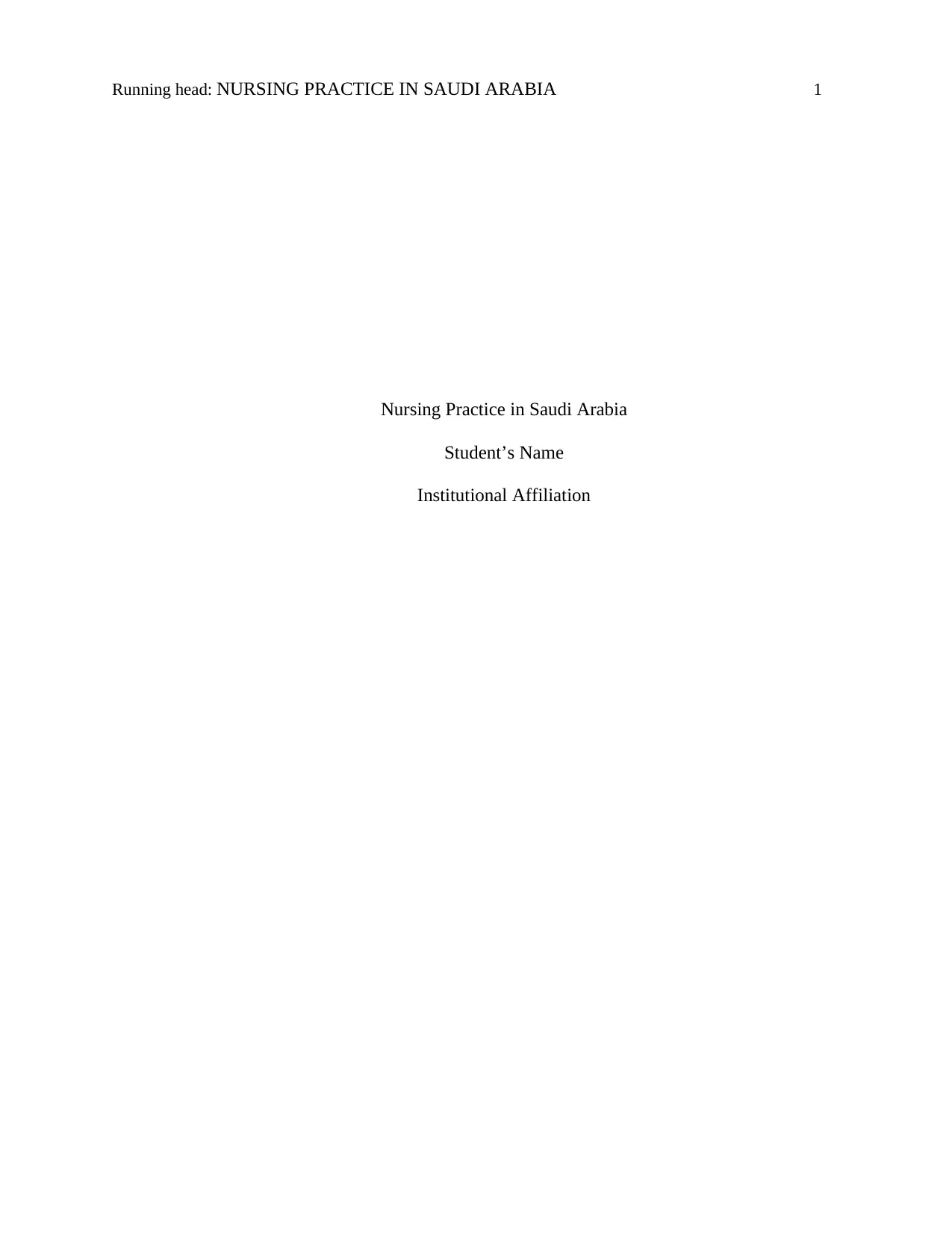
Running head: NURSING PRACTICE IN SAUDI ARABIA 1
Nursing Practice in Saudi Arabia
Student’s Name
Institutional Affiliation
Nursing Practice in Saudi Arabia
Student’s Name
Institutional Affiliation
Secure Best Marks with AI Grader
Need help grading? Try our AI Grader for instant feedback on your assignments.
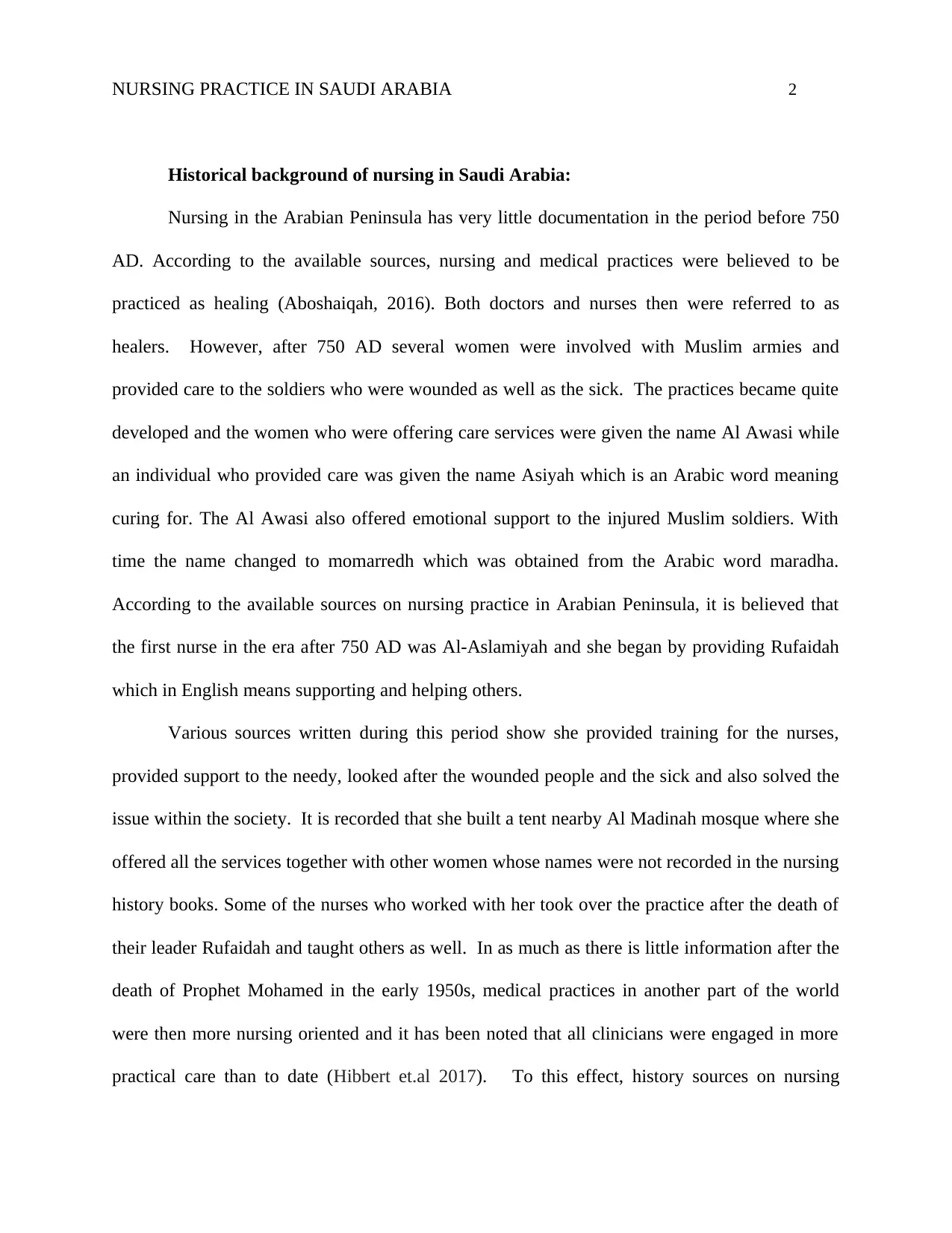
NURSING PRACTICE IN SAUDI ARABIA 2
Historical background of nursing in Saudi Arabia:
Nursing in the Arabian Peninsula has very little documentation in the period before 750
AD. According to the available sources, nursing and medical practices were believed to be
practiced as healing (Aboshaiqah, 2016). Both doctors and nurses then were referred to as
healers. However, after 750 AD several women were involved with Muslim armies and
provided care to the soldiers who were wounded as well as the sick. The practices became quite
developed and the women who were offering care services were given the name Al Awasi while
an individual who provided care was given the name Asiyah which is an Arabic word meaning
curing for. The Al Awasi also offered emotional support to the injured Muslim soldiers. With
time the name changed to momarredh which was obtained from the Arabic word maradha.
According to the available sources on nursing practice in Arabian Peninsula, it is believed that
the first nurse in the era after 750 AD was Al-Aslamiyah and she began by providing Rufaidah
which in English means supporting and helping others.
Various sources written during this period show she provided training for the nurses,
provided support to the needy, looked after the wounded people and the sick and also solved the
issue within the society. It is recorded that she built a tent nearby Al Madinah mosque where she
offered all the services together with other women whose names were not recorded in the nursing
history books. Some of the nurses who worked with her took over the practice after the death of
their leader Rufaidah and taught others as well. In as much as there is little information after the
death of Prophet Mohamed in the early 1950s, medical practices in another part of the world
were then more nursing oriented and it has been noted that all clinicians were engaged in more
practical care than to date (Hibbert et.al 2017). To this effect, history sources on nursing
Historical background of nursing in Saudi Arabia:
Nursing in the Arabian Peninsula has very little documentation in the period before 750
AD. According to the available sources, nursing and medical practices were believed to be
practiced as healing (Aboshaiqah, 2016). Both doctors and nurses then were referred to as
healers. However, after 750 AD several women were involved with Muslim armies and
provided care to the soldiers who were wounded as well as the sick. The practices became quite
developed and the women who were offering care services were given the name Al Awasi while
an individual who provided care was given the name Asiyah which is an Arabic word meaning
curing for. The Al Awasi also offered emotional support to the injured Muslim soldiers. With
time the name changed to momarredh which was obtained from the Arabic word maradha.
According to the available sources on nursing practice in Arabian Peninsula, it is believed that
the first nurse in the era after 750 AD was Al-Aslamiyah and she began by providing Rufaidah
which in English means supporting and helping others.
Various sources written during this period show she provided training for the nurses,
provided support to the needy, looked after the wounded people and the sick and also solved the
issue within the society. It is recorded that she built a tent nearby Al Madinah mosque where she
offered all the services together with other women whose names were not recorded in the nursing
history books. Some of the nurses who worked with her took over the practice after the death of
their leader Rufaidah and taught others as well. In as much as there is little information after the
death of Prophet Mohamed in the early 1950s, medical practices in another part of the world
were then more nursing oriented and it has been noted that all clinicians were engaged in more
practical care than to date (Hibbert et.al 2017). To this effect, history sources on nursing
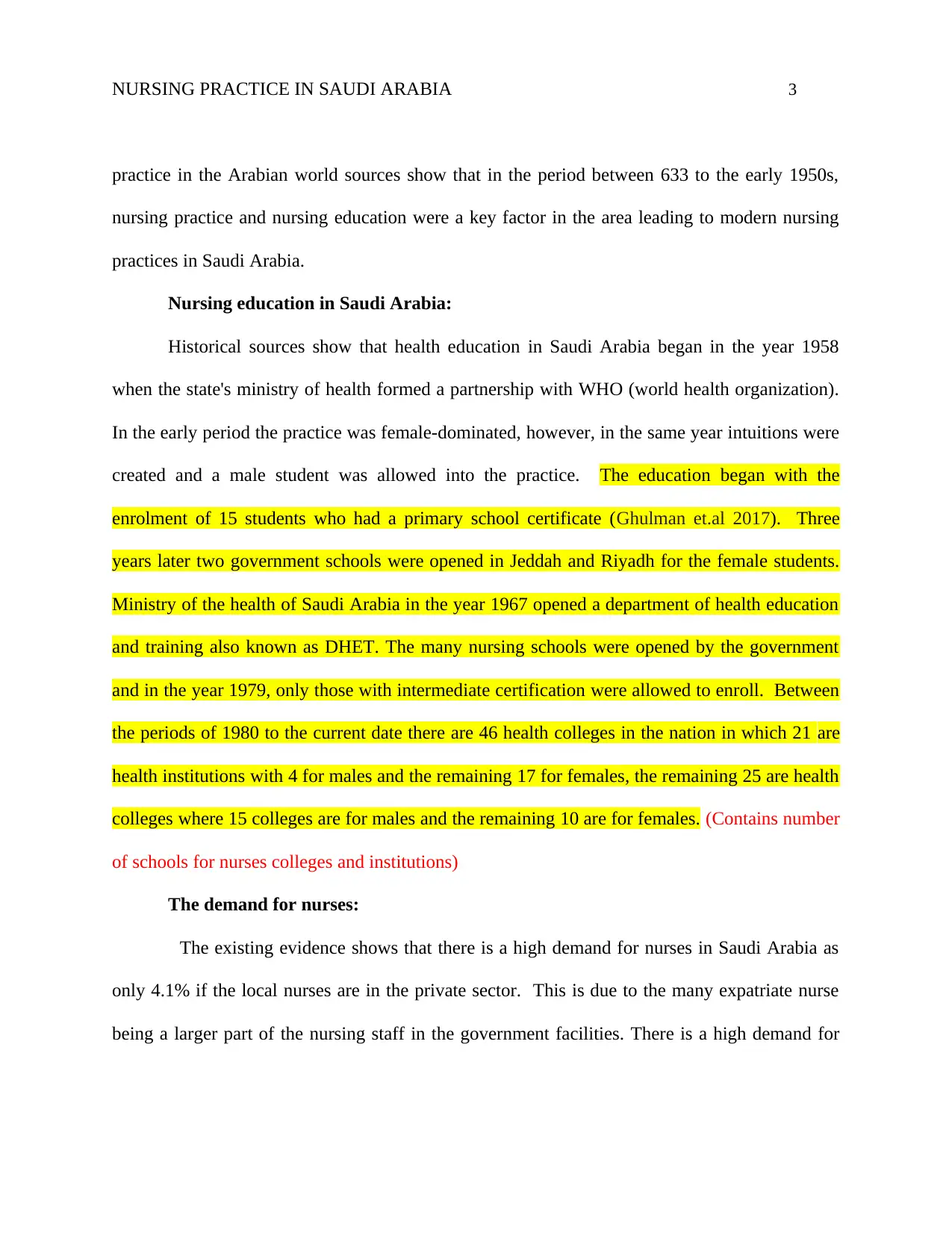
NURSING PRACTICE IN SAUDI ARABIA 3
practice in the Arabian world sources show that in the period between 633 to the early 1950s,
nursing practice and nursing education were a key factor in the area leading to modern nursing
practices in Saudi Arabia.
Nursing education in Saudi Arabia:
Historical sources show that health education in Saudi Arabia began in the year 1958
when the state's ministry of health formed a partnership with WHO (world health organization).
In the early period the practice was female-dominated, however, in the same year intuitions were
created and a male student was allowed into the practice. The education began with the
enrolment of 15 students who had a primary school certificate (Ghulman et.al 2017). Three
years later two government schools were opened in Jeddah and Riyadh for the female students.
Ministry of the health of Saudi Arabia in the year 1967 opened a department of health education
and training also known as DHET. The many nursing schools were opened by the government
and in the year 1979, only those with intermediate certification were allowed to enroll. Between
the periods of 1980 to the current date there are 46 health colleges in the nation in which 21 are
health institutions with 4 for males and the remaining 17 for females, the remaining 25 are health
colleges where 15 colleges are for males and the remaining 10 are for females. (Contains number
of schools for nurses colleges and institutions)
The demand for nurses:
The existing evidence shows that there is a high demand for nurses in Saudi Arabia as
only 4.1% if the local nurses are in the private sector. This is due to the many expatriate nurse
being a larger part of the nursing staff in the government facilities. There is a high demand for
practice in the Arabian world sources show that in the period between 633 to the early 1950s,
nursing practice and nursing education were a key factor in the area leading to modern nursing
practices in Saudi Arabia.
Nursing education in Saudi Arabia:
Historical sources show that health education in Saudi Arabia began in the year 1958
when the state's ministry of health formed a partnership with WHO (world health organization).
In the early period the practice was female-dominated, however, in the same year intuitions were
created and a male student was allowed into the practice. The education began with the
enrolment of 15 students who had a primary school certificate (Ghulman et.al 2017). Three
years later two government schools were opened in Jeddah and Riyadh for the female students.
Ministry of the health of Saudi Arabia in the year 1967 opened a department of health education
and training also known as DHET. The many nursing schools were opened by the government
and in the year 1979, only those with intermediate certification were allowed to enroll. Between
the periods of 1980 to the current date there are 46 health colleges in the nation in which 21 are
health institutions with 4 for males and the remaining 17 for females, the remaining 25 are health
colleges where 15 colleges are for males and the remaining 10 are for females. (Contains number
of schools for nurses colleges and institutions)
The demand for nurses:
The existing evidence shows that there is a high demand for nurses in Saudi Arabia as
only 4.1% if the local nurses are in the private sector. This is due to the many expatriate nurse
being a larger part of the nursing staff in the government facilities. There is a high demand for
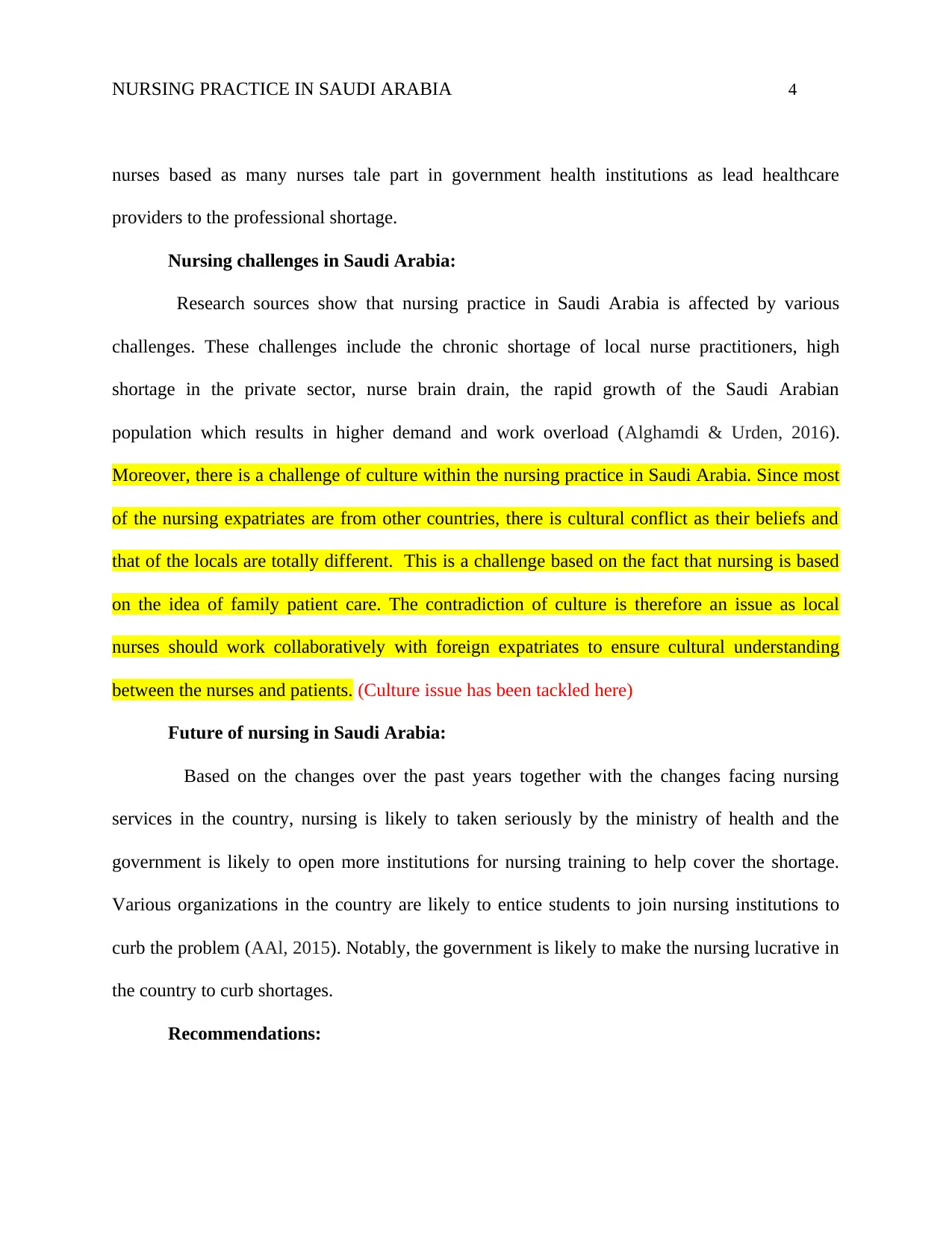
NURSING PRACTICE IN SAUDI ARABIA 4
nurses based as many nurses tale part in government health institutions as lead healthcare
providers to the professional shortage.
Nursing challenges in Saudi Arabia:
Research sources show that nursing practice in Saudi Arabia is affected by various
challenges. These challenges include the chronic shortage of local nurse practitioners, high
shortage in the private sector, nurse brain drain, the rapid growth of the Saudi Arabian
population which results in higher demand and work overload (Alghamdi & Urden, 2016).
Moreover, there is a challenge of culture within the nursing practice in Saudi Arabia. Since most
of the nursing expatriates are from other countries, there is cultural conflict as their beliefs and
that of the locals are totally different. This is a challenge based on the fact that nursing is based
on the idea of family patient care. The contradiction of culture is therefore an issue as local
nurses should work collaboratively with foreign expatriates to ensure cultural understanding
between the nurses and patients. (Culture issue has been tackled here)
Future of nursing in Saudi Arabia:
Based on the changes over the past years together with the changes facing nursing
services in the country, nursing is likely to taken seriously by the ministry of health and the
government is likely to open more institutions for nursing training to help cover the shortage.
Various organizations in the country are likely to entice students to join nursing institutions to
curb the problem (AAl, 2015). Notably, the government is likely to make the nursing lucrative in
the country to curb shortages.
Recommendations:
nurses based as many nurses tale part in government health institutions as lead healthcare
providers to the professional shortage.
Nursing challenges in Saudi Arabia:
Research sources show that nursing practice in Saudi Arabia is affected by various
challenges. These challenges include the chronic shortage of local nurse practitioners, high
shortage in the private sector, nurse brain drain, the rapid growth of the Saudi Arabian
population which results in higher demand and work overload (Alghamdi & Urden, 2016).
Moreover, there is a challenge of culture within the nursing practice in Saudi Arabia. Since most
of the nursing expatriates are from other countries, there is cultural conflict as their beliefs and
that of the locals are totally different. This is a challenge based on the fact that nursing is based
on the idea of family patient care. The contradiction of culture is therefore an issue as local
nurses should work collaboratively with foreign expatriates to ensure cultural understanding
between the nurses and patients. (Culture issue has been tackled here)
Future of nursing in Saudi Arabia:
Based on the changes over the past years together with the changes facing nursing
services in the country, nursing is likely to taken seriously by the ministry of health and the
government is likely to open more institutions for nursing training to help cover the shortage.
Various organizations in the country are likely to entice students to join nursing institutions to
curb the problem (AAl, 2015). Notably, the government is likely to make the nursing lucrative in
the country to curb shortages.
Recommendations:
Secure Best Marks with AI Grader
Need help grading? Try our AI Grader for instant feedback on your assignments.
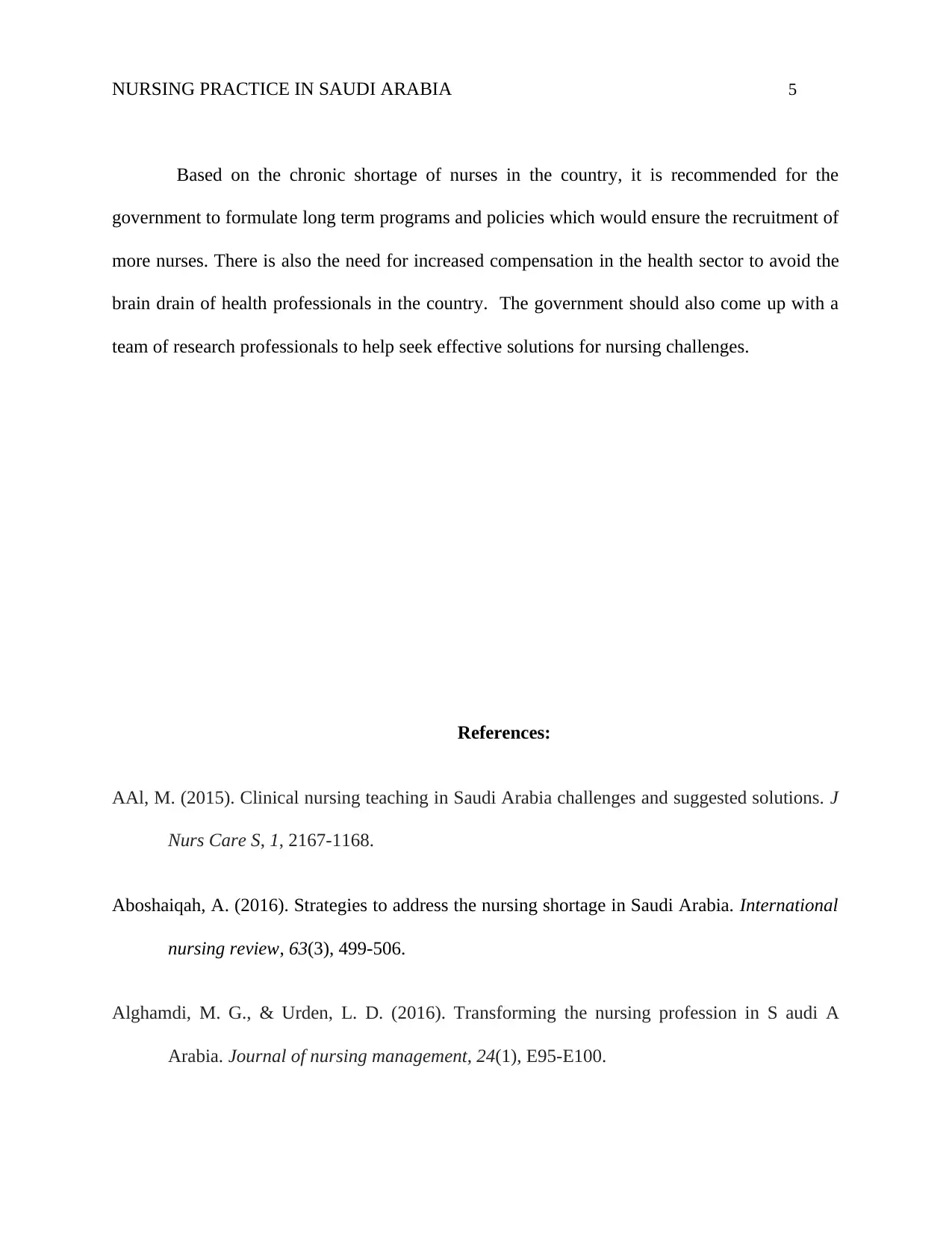
NURSING PRACTICE IN SAUDI ARABIA 5
Based on the chronic shortage of nurses in the country, it is recommended for the
government to formulate long term programs and policies which would ensure the recruitment of
more nurses. There is also the need for increased compensation in the health sector to avoid the
brain drain of health professionals in the country. The government should also come up with a
team of research professionals to help seek effective solutions for nursing challenges.
References:
AAl, M. (2015). Clinical nursing teaching in Saudi Arabia challenges and suggested solutions. J
Nurs Care S, 1, 2167-1168.
Aboshaiqah, A. (2016). Strategies to address the nursing shortage in Saudi Arabia. International
nursing review, 63(3), 499-506.
Alghamdi, M. G., & Urden, L. D. (2016). Transforming the nursing profession in S audi A
Arabia. Journal of nursing management, 24(1), E95-E100.
Based on the chronic shortage of nurses in the country, it is recommended for the
government to formulate long term programs and policies which would ensure the recruitment of
more nurses. There is also the need for increased compensation in the health sector to avoid the
brain drain of health professionals in the country. The government should also come up with a
team of research professionals to help seek effective solutions for nursing challenges.
References:
AAl, M. (2015). Clinical nursing teaching in Saudi Arabia challenges and suggested solutions. J
Nurs Care S, 1, 2167-1168.
Aboshaiqah, A. (2016). Strategies to address the nursing shortage in Saudi Arabia. International
nursing review, 63(3), 499-506.
Alghamdi, M. G., & Urden, L. D. (2016). Transforming the nursing profession in S audi A
Arabia. Journal of nursing management, 24(1), E95-E100.
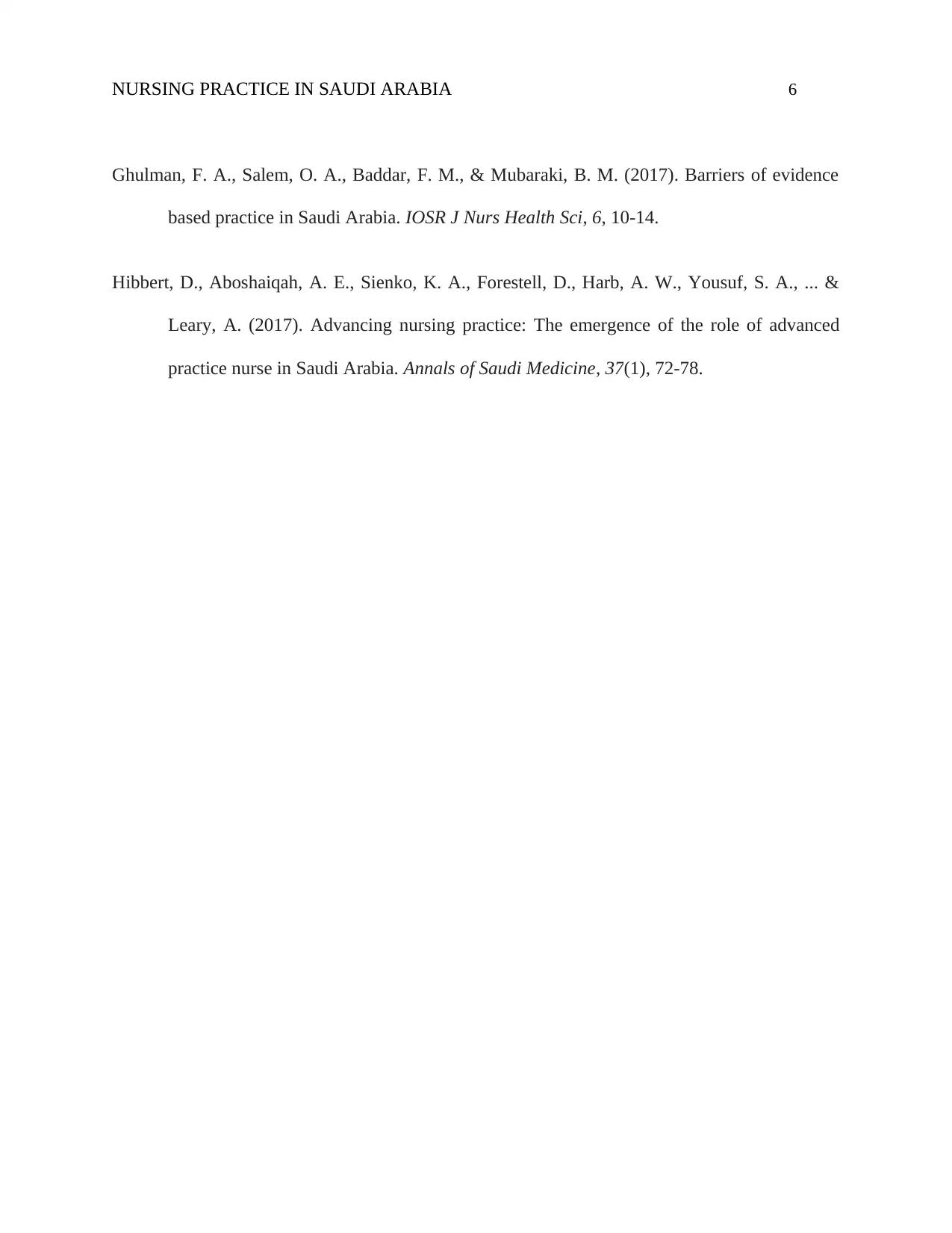
NURSING PRACTICE IN SAUDI ARABIA 6
Ghulman, F. A., Salem, O. A., Baddar, F. M., & Mubaraki, B. M. (2017). Barriers of evidence
based practice in Saudi Arabia. IOSR J Nurs Health Sci, 6, 10-14.
Hibbert, D., Aboshaiqah, A. E., Sienko, K. A., Forestell, D., Harb, A. W., Yousuf, S. A., ... &
Leary, A. (2017). Advancing nursing practice: The emergence of the role of advanced
practice nurse in Saudi Arabia. Annals of Saudi Medicine, 37(1), 72-78.
Ghulman, F. A., Salem, O. A., Baddar, F. M., & Mubaraki, B. M. (2017). Barriers of evidence
based practice in Saudi Arabia. IOSR J Nurs Health Sci, 6, 10-14.
Hibbert, D., Aboshaiqah, A. E., Sienko, K. A., Forestell, D., Harb, A. W., Yousuf, S. A., ... &
Leary, A. (2017). Advancing nursing practice: The emergence of the role of advanced
practice nurse in Saudi Arabia. Annals of Saudi Medicine, 37(1), 72-78.
1 out of 6
Your All-in-One AI-Powered Toolkit for Academic Success.
+13062052269
info@desklib.com
Available 24*7 on WhatsApp / Email
![[object Object]](/_next/static/media/star-bottom.7253800d.svg)
Unlock your academic potential
© 2024 | Zucol Services PVT LTD | All rights reserved.